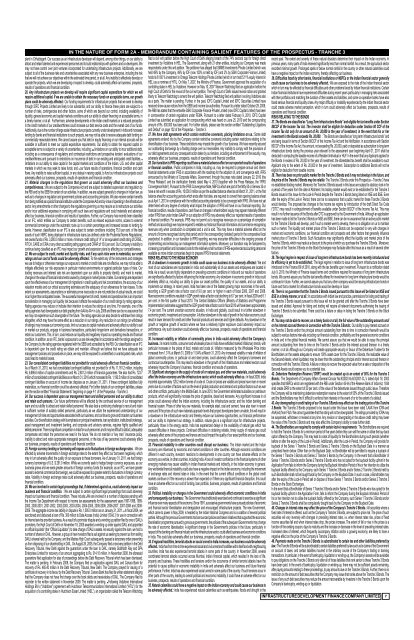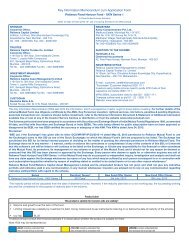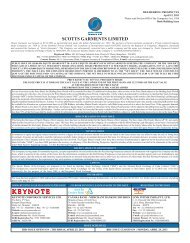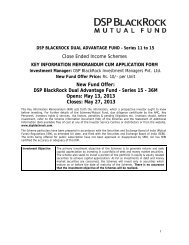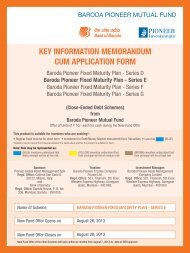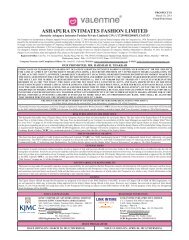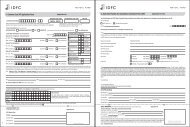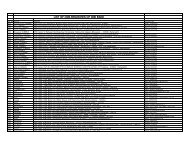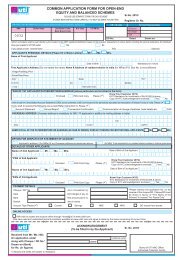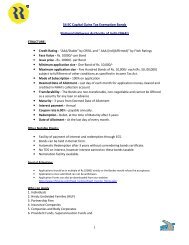Download Rest Pages - Rrfinance.com
Download Rest Pages - Rrfinance.com
Download Rest Pages - Rrfinance.com
- No tags were found...
Create successful ePaper yourself
Turn your PDF publications into a flip-book with our unique Google optimized e-Paper software.
7IN THE NATURE OF FORM 2A - MEMORANDUM CONTAINING SALIENT FEATURES OF THE PROSPECTUS - TRANCHE 3INFRASTRUCTURE DEVELOPMENT FINANCE COMPANY LIMITEDplant in Chhattisgarh. Our success as an infrastructure developer will depend, among other things, on our ability toattract and retain talented and experienced personnel and to build relationships with partners and co-developers. Wemay not have control over joint ventures incorporated for undertaking infrastructure projects. Additionally, we aresubject to all of the business risks and uncertainties associated with any new business enterprise, including the riskthat we will not achieve our objectives within the estimated time period, or at all. Any inability to effectively develop oroperate the projects, which we are developing or expect to develop, could adversely affect our business, prospects,results of operations and financial condition.20. Any infrastructure projects we develop will require significant capital expenditure for which we willrequire additional capital. If we are unable to obtain the necessary funds on acceptable terms, our growthplans could be adversely affected.: Our funding requirements for infrastructure projects that we seek to developthrough IDFC Projects Limited are likely to be substantial, and our ability to finance these plans are subject to anumber of risks, contingencies and other factors, some of which are beyond our control, including availability ofliquidity, general economic and capital markets conditions and our ability to obtain financing on acceptable terms, ina timely manner, or at all. Furthermore, adverse developments in the Indian credit markets or a reduced perceptionin the credit markets of our creditworthiness could increase our debt service costs and the overall cost of our funds.Additionally, due to the number of large scale infrastructure projects currently under development in India and increasedlending by banks and financial institutions to such projects, we may not be able to receive adequate debt funding on<strong>com</strong>mercially reasonable terms. We cannot assure you that debt or equity financing or our internal accruals will beavailable or sufficient to meet our capital expenditure requirements. Our ability to obtain the required capital onacceptable terms is subject to a variety of uncertainties, including: ● ● limitations on our ability to incur additional debt,including as a consequence of regulatory and contractual restrictions and prospective lenders’ evaluations of ourcreditworthiness and pursuant to restrictions on incurrence of debt in our existing and anticipated credit facilities; ●limitations on our ability to raise capital in the capital markets and conditions of the Indian, U.S. and other capitalmarkets in which we may seek to raise funds; and ● our future results of operations, financial condition and cashflows. Any inability to raise sufficient capital, or any delays in raising capital, to fund our infrastructure projects couldadversely affect our business, prospects, results of operations and financial condition.21. Material changes in the regulations that govern us could adversely affect our business and<strong>com</strong>petitiveness.: We are subject to the Companies Act and are subject to detailed supervision and regulation bythe RBI and by the SEBI for certain of our activities. In addition, we are subject generally to changes in Indian law, aswell as to changes in regulation and government policies and accounting principles. We also receive certain benefitsfrom being notified as a public financial institution under the Companies Act and by virtue of operating in the infrastructuresector. Any amendments or other changes to the regulations governing us may require us to restructure our activitiesand/or incur additional expenses in <strong>com</strong>plying with such laws and regulations and could materially and adverselyaffect our business, financial condition and results of operations. Further, our Company has recently been classifiedas an IFC, which entitles our Company to certain benefits, such as relaxed exposure norms, access to external<strong>com</strong>mercial borrowings under the automatic route up to a certain percentage and increased access to lending bybanks. However, classification as an IFC is also subject to certain conditions including 75.0 per cent. of the totalassets of such NBFC being deployed in infrastructure loans (as defined under the Prudential Norms Regulations),net owned funds of Rs. 3,000.0 million or more, minimum credit rating of “A” or an equivalent credit rating of CRISIL,FITCH, CARE or ICRA or any other accrediting rating agency and CRAR of 15.0 per cent. Our Company’s inability tocontinue being classified as an IFC may impact our growth and expansion plans by affecting our <strong>com</strong>petitiveness.22. We are subject to credit, market and liquidity risks, and if any such risks were to materialize, our creditratings and our cost of funds could be adversely affected.: To the extent any of the instruments and strategieswe use to hedge or otherwise manage our exposure to market or credit risks are not effective, we may not be able tomitigate effectively our risk exposures in particular market environments or against particular types of risks. Ourtrading revenues and interest rate risk are dependent upon our ability to properly identify, and mark to market,changes in the value of financial instruments caused by changes in market prices or rates. Our earnings are dependentupon the effectiveness of our management of migrations in credit quality and risk concentrations, the accuracy of ourvaluation models and our critical accounting estimates and the adequacy of our allowances for loan losses. To theextent our assessments, assumptions or estimates prove inaccurate or are not predictive of actual results, we couldincur higher than anticipated losses. The successful management of credit, market and operational risk is an importantconsideration in managing our liquidity risk because it affects the evaluation of our credit ratings by rating agencies.Rating agencies may reduce or indicate their intention to reduce the ratings at any time. For example, one of therating agencies had downgraded our debt grading from AAA to AA+ in July, 2009 and there can be no assurance thatwe may not experience such downgrade in the future. The rating agencies can also decide to withdraw their ratingsaltogether, which may have the same effect as a reduction in our ratings. Any reduction in our ratings (or withdrawalof ratings) may increase our borrowing costs, limit our access to capital markets and adversely affect our ability to sellor market our products, engage in business transactions, particularly longer-term and derivatives transactions, orretain our customers. This, in turn, could reduce our liquidity and negatively impact our operating results and financialcondition. In addition, as an IFC, banks’ exposures to us are risk-weighted in accordance with the ratings assigned tothe Company by the rating agencies registered with the SEBI and accredited by the RBI. Our classification as an IFCis dependent upon the credit rating we obtain and maintain. Although we believe that we have adequate riskmanagement policies and procedures in place, we may still be exposed to unidentified or unanticipated risks, whichcould lead to material losses.23. Our consolidated contingent liabilities not provided for could adversely affect our financial condition.:As of March 31, 2010, we had consolidated contingent liabilities not provided for of Rs. 11,161.2 million, includingRs. 6,896.6 million of capital <strong>com</strong>mitments and Rs. 2,801.2 million of financial guarantees. We also had Rs. 723.7million of consolidated contingent liabilities as on March 31, 2010 which increased to Rs. 1,190.5 million of consolidatedcontingent liabilities on account of in<strong>com</strong>e tax disputes as on January 31, 2011. If these contingent liabilities fullymaterialize, our financial condition could be adversely affected. For further details of our contingent liabilities, pleasesee the section entitled “Financial Statements” beginning on page F-1 of the Prospectus - Tranche 3.24. Our success is dependent upon our management team and skilled personnel and our ability to attractand retain such persons.: Our future performance will be affected by the continued service of our managementteam and our ability to attract and retain skilled personnel. We also face a continuing challenge to recruit and retaina sufficient number of suitably skilled personnel, particularly as we utilize the experienced understanding of ourmanagement of risks and opportunities associated with our business, and continue to grow and broaden our businessactivities. Our diversification strategy with its emphasis on principal investments, loan syndication, institutional brokerage,asset management and investment banking, and corporate and advisory services, requires highly qualified andskilled personnel. There is significant <strong>com</strong>petition in India for such personnel, and it may be difficult to attract, adequately<strong>com</strong>pensate and retain the personnel we need in the future. We do not maintain a “key man” insurance policy.Inability to attract and retain appropriate managerial personnel, or the loss of key personnel could adversely affectour business, prospects, results of operations and financial condition.25. Foreign currency lending or borrowing will expose us to fluctuations in foreign exchange rates. : We areaffected by adverse movements in foreign exchange rates to the extent they affect our borrowers negatively, whichmay in turn adversely affect the quality of our exposure to these borrowers. As of January 31, 2011, we had foreigncurrency borrowings of U.S. $ 291.0 million. While we currently seek to hedge foreign currency exposures, as ourbusiness grows and we seek greater amounts of foreign currency funds (for example, as an IFC, we have greateraccess to external <strong>com</strong>mercial borrowings), we could be exposed to a greater extent to fluctuations in foreign currencyrates. Volatility in foreign exchange rates could adversely affect our business, prospects, results of operations andfinancial condition.26. We are involved in certain legal proceedings that, if determined against us, could adversely impact ourbusiness and financial condition. : We are subject to certain significant legal proceedings that could adverselyimpact our business and financial condition. These include:● We are involved in a number of disputes pending withthe In<strong>com</strong>e Tax Department with respect to in<strong>com</strong>e tax assessments for the assessment years 1997-1998, 1999-2000, 2000-2001, 2001-2002, 2002-2003, 2003-2004, 2004-2005, 2005-2006, 2006-2007, 2007-2008 and 2008-2009. The aggregate in<strong>com</strong>e tax liability in dispute is Rs. 1,095.0 million as on January 31, 2011. ● In fiscal 2004, wesanctioned and disbursed a loan of Rs. 300 million to Data Access (India) Limited (“DAIL”) for use in connection withits Internet service provider business. As a result of a promoter dispute and a winding up petition filed by one of DAIL’spromoters, the High Court of Delhi on November 18, 2005 awarded a winding up order against DAIL and appointedan official liquidator (the “Official Liquidator”) to take charge of DAIL’s assets. As security against the loan, we hold anumber of shares in DAIL. However, a group of new investors filed a suit against us seeking to prevent us from sellingDAIL’s shares held by the Company, and the Madras High Court subsequently passed a temporary order preventingus from disposing of our shareholding in DAIL. On August 26, 2005, the Company filed a recovery petition in the DebtRecovery Tribunal, New Delhi against the guarantors under the loan to DAIL, namely Siddharth Ray and SPAEnterprises Limited for recovery of an amount aggregating to Rs. 314.10 million. In November 2008, the aforesaidguarantors filed application for stay of proceedings before the Debt Recovery Tribunal which has been dismissed.The matter is pending. In February 2008, the Company filed an application against DAIL and Canara Bank forrecovery of Rs. 465.40 million in the Debt Recovery Tribunal, New Delhi. The Company prayed for issuing of acertificate of recovery in its favour by the Debt Recovery Tribunal. Canara Bank has filed its written statement allegingthat the Company does not have first charge over the book debts and receivables of DAIL. The Company filed itsrejoinder to the written statement in November 2009. The matter is pending. ● Following Vodafone InternationalHoldings BV’s (“Vodafone”) agreement with Hutchison Tele<strong>com</strong>munications International Limited (“HTIL”) for theacquisition of a controlling stake in Hutchison Essar Limited (“HEL”), an organization called the Tele<strong>com</strong> Watchdogfiled a civil writ petition before the High Court of Delhi alleging breach of the 74% sectoral cap for foreign directinvestment by Vodafone in HEL. The Government, along with 21 other entities, including our Company was maderespondents under this writ petition. The petitioner has alleged that SMMS Investments Private Limited (which washeld 49% by the Company, 49% by IDF (now 100% is held by IDF) and 2% by SSKI Corporate Finance Limited)holds its 61.60 % investment in Omega Tele<strong>com</strong> Holdings Private Limited (which in turn held 5.11% equity interest inHEL) as a nominee of HTIL. On May 7, 2007, the Ministry of Finance, Government approved the acquisition of acontrolling stake in HEL by Vodafone. However on May 10, 2007 Tele<strong>com</strong> Watchdog filed an application before theHigh Court of Delhi for the revival of the civil writ petition. The High Court of Delhi issued revival notice and grantedliberty to Tele<strong>com</strong> Watchdog to amend the writ petition. Tele<strong>com</strong> Watchdog filed writ petition involving Vodafone alsoas a party. The matter is pending. Further, in the past, IDFC Capital Limited and IDFC Securities Limited havereceived show-cause notices from the SEBI and in<strong>com</strong>e tax authorities. Pursuant to a letter dated October 29, 2009,the RBI has stated that the erstwhile SSKI Corporate Finance Private Limited (now IDFC Capital Limited) has beenin contravention of certain regulations under FEMA. Pursuant to a letter dated February 9, 2010, IDFC CapitalLimited has submitted an application for <strong>com</strong>pounding which was heard on June 25, 2010 and the <strong>com</strong>poundingamount of Rs. 500,000 has been paid. For further details, please see the section entitled “Outstanding Litigationsand Default” on page 102 of the Prospectus - Tranche 3.27. We have debt agreements which contain restrictive covenants, placing limitations on us.: Some debtagreements entered into by the Company contain restrictive covenants including certain restrictions relating to thediversification of our business. These restrictions may impede the growth of our business. We have recently securedour outstanding borrowings by a floating charge over our receivables. Any inability to <strong>com</strong>ply with the provisions ofour debt agreements and any consequent action taken by our lenders, including an enforcement of the security, mayadversely affect our business, prospects, results of operations and financial condition.28. Our transition to IFRS reporting could have a material adverse effect on our reported results of operationsor financial condition.: Public <strong>com</strong>panies in India, including us, may be required to prepare annual and interimfinancial statements under IFRS in accordance with the roadmap for the adoption of, and convergence with, IFRSannounced by the Ministry of Corporate Affairs, Government, through the press note dated January 22, 2010 (the“Press Release”) and the clarification thereto dated May 4, 2010 (together with the Press Release, the “IFRSConvergence Note”). Pursuant to the IFRS Convergence Note, NBFCs which are part of the Nifty 50 or Sensex 30 orhave a net worth in excess of Rs. 10,000.0 million as per the audited balance sheet as at March 31, 2011, or the firstbalance sheet for accounting periods which ends after that date, are required to convert their opening balance sheetas at April 1, 2013 in <strong>com</strong>pliance with the notified accounting standards to be converged with IFRS. We have not yetdetermined with any degree of certainty what impact the adoption of IFRS will have on our financial reporting. Ourfinancial condition, results of operations, cash flows or changes in shareholders’ equity may appear materially differentunder IFRS than under Indian GAAP or our adoption of IFRS may adversely affect our reported results of operationsor financial condition. For example, IFRS may not permit us to recognise revenues on a percentage of <strong>com</strong>pletionmethod and accordingly we may be required to restate our historical financial information and <strong>com</strong>mence recognisingrevenues only when construction is <strong>com</strong>pleted and a unit is sold. This may have a material adverse effect on theamount of in<strong>com</strong>e recognised during that period and in the corresponding (restated) period in the <strong>com</strong>parative fiscalyear/period. In addition, in our transition to IFRS reporting, we may encounter difficulties in the ongoing process ofimplementing and enhancing our management information systems. Moreover, our transition may be hampered byincreasing <strong>com</strong>petition and increased costs for the relatively small number of IFRS-experienced accounting personnelavailable as more Indian <strong>com</strong>panies begin to prepare IFRS financial statements.RISKS RELATING TO THE INDIAN ECONOMY29. A slowdown in economic growth in India could cause our business to be adversely affected.: We andmost of our subsidiaries are incorporated in India, and substantially all of our assets and employees are located inIndia. As a result, we are highly dependent on prevailing economic conditions in India and our results of operationsare significantly affected by factors influencing the Indian economy. Any slowdown in economic growth in India couldadversely affect us, including our ability to grow our asset portfolio, the quality of our assets, and our ability toimplement our strategy. In recent years, India has been one of the fastest growing major economies in the world,recording a GDP growth rate at factor cost of 9.0 per cent. or higher in each of fiscal 2006, 2007 and 2008.Macroeconomic conditions resulted in GDP growth rates at factor cost declining to 6.7 per cent. in fiscal 2009 and 6.1per cent. in the first quarter of fiscal 2010. The Central Statistics Office’s (Ministry of Statistics and ProgrammeImplementation) estimates suggest that the GDP growth rate at factor cost in fiscal 2010 will have been approximately7.4 per cent. The current uncertain economic situation, in India and globally, could result in a further slowdown ineconomic growth, investment and consumption. A further slowdown in the rate of growth in the Indian economy couldresult in lower demand for credit and other financial products and services and higher defaults. Any slowdown in thegrowth or negative growth of sectors where we have a relatively higher exposure could adversely impact ourperformance. Any such slowdown could adversely affect our business, prospects, results of operations and financialcondition.30. Increased volatility or inflation of <strong>com</strong>modity prices in India could adversely affect the Company’sbusiness.: In recent months, consumer and wholesale prices in India have exhibited marked inflationary trends, withparticular increases in the prices of food, metals and crude oil. Inflation measured by the Wholesale Price Indexincreased from 1.31% at March 31, 2009 to 11.04% at March 31, 2010. Any increased volatility or rate of inflation ofglobal <strong>com</strong>modity prices, in particular oil and steel prices, could adversely affect the Company’s borrowers andcontractual counterparties. This may lead to slowdown in the growth of the infrastructure and related sectors couldadversely impact the Company’s business, financial condition and results of operations.31. Significant shortages in the supply of crude oil or natural gas, and other raw materials, could adverselyaffect the Indian economy and the infrastructure sector, which could adversely affect us.: In fiscal 2009, Indiaimported approximately 128.2 million tonnes of crude oil. Crude oil prices are volatile and prices have risen in recentyears due to a number of factors such as the level of global production and demand and political factors such as warand other conflicts, particularly in the Middle East. In June 2010, the Government eliminated subsidies on petroleumproducts, which will significantly increase the price of gasoline, diesel and kerosene. Any significant increase in oilprices could adversely affect the Indian economy, including the infrastructure sector, and the Indian banking andfinancial system. Prices of other key raw materials, for example steel, coal and cement, have also risen in recentyears and if the prices of such raw materials approach levels that project developers deem unviable, this will result ina slowdown in the infrastructure sector and thereby reduce our business opportunities, our financial performanceand our ability to implement our strategy. In addition, natural gas is a significant input for infrastructure projects,particularly those in the energy sector. India has experienced delays in the availability of natural gas which hascaused difficulties in these projects. Continued difficulties in obtaining reliable, timely supply of natural gas couldadversely affect some of the projects we finance and could impact the quality of our asset portfolio and our business,prospects, results of operations and financial condition.32. Financial instability in other countries could disrupt our business.: The Indian market and the Indianeconomy are influenced by economic and market conditions in other countries. Although economic conditions aredifferent in each country, investors’ reactions to developments in one country can have adverse effects on theeconomy as a whole, in other countries, including India. A loss of investor confidence in the financial systems of otheremerging markets may cause volatility in Indian financial markets and indirectly, in the Indian economy in general.Any worldwide financial instability could also have a negative impact on the Indian economy, including the movementof exchange rates and interest rates in India. In the event that the current difficult conditions in the global creditmarkets continue or if the recovery is slower than expected or if there any significant financial disruption, this couldhave an adverse effect on our cost of funding, loan portfolio, business, prospects, results of operations and financialcondition.33. Political instability or changes in the Government could adversely affect economic conditions in Indiaand consequently, our business.: The Government has traditionally exercised and continues to exercise a significantinfluence over many aspects of the economy. Since 1991, successive governments have pursued policies of economicand financial sector liberalisation and deregulation and encouraged infrastructure projects. The new Government,which came to power in May 2009, is headed by the Indian National Congress and is a coalition of several politicalparties. Although the previous Governments had announced policies and taken initiatives that supported the economicliberalisation programme pursued by previous governments, the policies of the subsequent Governments may changethe rate of economic liberalisation. A significant change in the Government’s policies in the future, particularly inrespect of the banking and finance industry and the infrastructure sector, could affect business and economic conditionsin India. This could also adversely affect our business, prospects, results of operations and financial condition.34. If regional hostilities, terrorist attacks or social unrest in India increases, our business could be adverselyaffected.: India has from time to time experienced social and civil unrest and hostilities within itself and with neighbouringcountries. India has also experienced terrorist attacks in some parts of the country. In November 2008, severalcoordinated terrorist attacks occurred across Mumbai, India’s financial capital, which resulted in the loss of life,property and business. These hostilities and tensions and/or the occurrence of similar terrorist attacks have thepotential to cause political or economic instability in India and adversely affect our business and future financialperformance. Further, India has also experienced social unrest in some parts of the country. If such tensions occur inother parts of the country, leading to overall political and economic instability, it could have an adverse effect on ourbusiness, prospects, results of operations and financial condition.35. Natural calamities could have a negative impact on the Indian economy and could cause our business tobe adversely affected.: India has experienced natural calamities such as earthquakes, floods and drought in therecent past. The extent and severity of these natural disasters determine their impact on the Indian economy. Inprevious years, many parts of India received significantly less than normal rainfall. As a result, the agricultural sectorrecorded minimal growth. Prolonged spells of below normal rainfall in the country or other natural calamities couldhave a negative impact on the Indian economy, thereby affecting our business.36. Difficulties faced by other banks, financial institutions or NBFCs or the Indian financial sector generallycould cause our business to be adversely affected.: We are exposed to the risks of the Indian financial sectorwhich in turn may be affected by financial difficulties and other problems faced by Indian financial institutions. CertainIndian financial institutions have experienced difficulties during recent years particularly in managing risks associatedwith their portfolios and matching the duration of their assets and liabilities, and some co-operative banks have alsofaced serious financial and liquidity crises. Any major difficulty or instability experienced by the Indian financial sectorcould create adverse market perception, which in turn could adversely affect our business, prospects, results ofoperations and financial condition.RISKS RELATING TO THE BONDS37. The Bonds are classified as “Long Term Infrastructure Bonds” and eligible for tax benefits under Section80CCF of the In<strong>com</strong>e Tax Act. The investor shall be eligible for deduction under Section 80 CCF of theIn<strong>com</strong>e Tax Act only for an amount of Rs. 20,000 in the year of investment, in the event that his or herinvestment in the Bonds exceeds Rs. 20,000. : The Bonds are classified as “long term infrastructure bonds” andare being issued in terms of Section 80CCF of the In<strong>com</strong>e Tax Act and the Notification. In accordance with Section80CCF of the In<strong>com</strong>e Tax Act, the amount, not exceeding Rs. 20,000, paid or deposited as subscription to long-terminfrastructure bonds during the previous year relevant to the assessment year beginning April 01, 2011 shall bededucted in <strong>com</strong>puting the taxable in<strong>com</strong>e of a Resident Individual or HUF. In the event that any Applicant applies forthe Bonds in excess of Rs. 20,000 in the year of investment, the aforestated tax benefit shall be available to suchApplicant only to the extent of Rs. 20,000 in the year of investment. Subscription to additional Bonds will not beeligible for deduction from taxable in<strong>com</strong>e.38. There has been no prior public market for the Tranche 3 Bonds and it may not develop in the future, andthe price of the Tranche 3 Bonds may be volatile: The Tranche 3 Bonds under this Prospectus – Tranche 3 haveno established trading market. Moreover, the Tranche 3 Bonds issued in this Issue are subject to statutory lock-in fora period of five years from the date of Allotment. No trading market would exist or be established for the Tranche 3Bonds issued in this Issue for the Lock-In Period despite the Tranche 3 Bonds being listed on NSE and BSE. Evenafter the expiry of the Lock-in Period, there can be no assurance that a public market for these Tranche 3 Bondswould develop. The proposed tax changes to the in<strong>com</strong>e tax regime by introduction of the draft Direct Tax Code(“DTC”) may result in extinguishment of benefits available under Section 80CCF of the In<strong>com</strong>e Tax Act. This mayresult in no further issuance of the Bonds after DTC is approved by the Government of India. Although an applicationhas been made to list the Tranche 3 Bonds on NSE and BSE, there can be no assurance that an active public marketfor the Tranche 3 Bonds will develop, and if such a market were to develop, there is no obligation on us to maintainsuch a market. The liquidity and market prices of the Tranche 3 Bonds can be expected to vary with changes inmarket and economic conditions, our financial condition and prospects and other factors that generally influencemarket price of Tranche 3 Bonds. Such fluctuations may significantly affect the liquidity and market price of theTranche 3 Bonds, which may trade at a discount to the price at which you purchase the Tranche 3 Bonds. Moreover,the price of the Tranche 3 Bonds on the Stock Exchanges may fluctuate after this Issue as a result of several otherfactors.39. The legal regime in respect of issue of long term infrastructure bonds has been recently introduced andits efficiency is yet to be established.: The legal regime in relation to issue of long term infrastructure bonds wasintroduced in the Finance Bill of 2010, along with the tax benefits upon investment. Pursuant to a notification datedJuly 9, 2010, the Ministry of Finance issued terms and conditions required for issuance of long term infrastructurebonds. We cannot assure you that the tax benefits offered for investment in long term infrastructure bonds would becontinued in future. Further, we cannot assure you that any other <strong>com</strong>pany would be issuing infrastructure bonds infuture and that a market for infrastructure bonds would be develop in future.40. There is no guarantee that the Tranche 3 Bonds issued pursuant to this Issue will be listed on NSE andBSE in a timely manner, or at all.: In accordance with Indian law and practice, permissions for listing and trading ofthe Tranche 3 Bonds issued pursuant to this Issue will not be granted until after the Tranche 3 Bonds have beenissued and allotted. Approval for listing and trading will require all relevant documents authorising the issuing ofTranche 3 Bonds to be submitted. There could be a failure or delay in listing the Tranche 3 Bonds on the StockExchanges.41. You may not be able to recover, on a timely basis or at all, the full value of the outstanding amounts and/or the interest accrued thereon in connection with the Tranche 3 Bonds.: Our ability to pay interest accrued onthe Tranche 3 Bonds and/or the principal amount outstanding from time to time in connection therewith would besubject to various factors inter-alia including our financial condition, profitability and the general economic conditionsin India and in the global financial markets. We cannot assure you that we would be able to repay the principalamount outstanding from time to time on the Tranche 3 Bonds and/or the interest accrued thereon in a timelymanner, or at all. Although our Company will create appropriate security in favour of the Debenture Trustee for theBondholders on the assets adequate to ensure 100% asset cover for the Tranche 3 Bonds, the realizable value ofthe Secured Assets, when liquidated, may be lower than the outstanding principal and/or interest accrued thereon inconnection with the Tranche 3 Bonds. A failure or delay to recover the expected value from a sale or disposition of theSecured Assets could expose you to a potential loss.42. Debenture Redemption Reserve (“DRR”) would be created up to an extent of 50% for the Tranche 3Bonds.: The Department of Company Affairs General Circular No.9/2002 No.6/3/2001-CL.V dated April 18, 2002specifies that NBFCs which are registered with the RBI under Section 45-IA of the Reserve Bank of India Act, 1934shall create DRR to the extent of 50 per cent. of the value of the debentures issued through public issue. Thereforethe Company will be maintaining debenture redemption reserve to the extent of 50% of the Tranche 3 Bonds issuedand the Bondholders may find it difficult to enforce their interests in the event of or to the extent of a default.43. Any downgrading in credit rating of our Tranche 3 Bonds may affect our the trading price of the Tranche3 Bonds: The Tranche 3 Bonds proposed to be issued under this Issue have been rated ‘LAAA’ from ICRA andAAA(ind) from Fitch. We cannot guarantee that this rating will not be downgraded. The ratings provided by ICRA maybe suspended, withdrawn or revised at any time. Any revision or downgrading in the above credit rating may lowerthe value of the Tranche 3 Bonds and may also affect the Company’s ability to raise further debt.44. The Bondholders are required to <strong>com</strong>ply with certain lock-in requirements : The Bondholders are requiredto hold the Tranche 3 Bonds for a minimum period of five years before they can sell the same or utilise the buy-backoption offered by the Company. This may lead to a lack of liquidity for the Bondholders during such periods (whetherbefore or after the expiry of the Lock-in Period). Additionally, after the Lock-in Period, the Company will provide forbuyback of the Series 1 Tranche 3 Bonds and Series 2 Tranche 3 Bonds on the Buyback Date in a manner asprescribed herein below. Other than on the Buyback Date, no Bondholder will be permitted to require a buyback ofthe Series 1 Tranche 3 Bonds and Series 2 Tranche 3 Bonds by the Company. In the event that a Bondholder ofSeries 1 Tranche 3 Bonds and/or Series 2 Tranche 3 Bonds who has not opted for the buyback facility upfront in theApplication Form fails to inform the Company during the Buyback Intimation Period of his or her intention to utilize thebuyback facility offered by the Company, such Series 1 Tranche 3 Bonds and/or Series 2 Tranche 3 Bonds held bysuch Bondholder shall not be bought back by the Company on the Buyback Date. In such a case, a Bondholder mayafter the expiry of the Lock-in Period sell or dispose of those Series 1 Tranche 3 Bonds and/or Series 2 Tranche 3Bonds on the Stock Exchanges.In the event that a Bondholder of Series 1 Tranche 3 Bonds and/or Series 2 Tranche 3 Bonds who has opted for thebuyback facility upfront in the Application Form, fails to inform the Company during the Buyback Intimation Period ofhis or her intention not to utilise the buyback facility offered by the Company, such Series 1 Tranche 3 Bonds and/orSeries 2 Tranche 3 Bonds shall be <strong>com</strong>pulsorily bought back by the Company on the Buyback Date.45. Changes in interest rates may affect the price of the Company’s Tranche 3 Bonds.: All securities where afixed rate of interest is offered, such as the Company’s Tranche 3 Bonds, are subject to price risk. The price of suchsecurities will vary inversely with changes in prevailing interest rates, i.e. when interest rates rise, prices of fixedin<strong>com</strong>e securities fall and when interest rates drop, the prices increase. The extent of fall or rise in the prices is afunction of the existing coupon, days to maturity and the increase or decrease in the level of prevailing interest rates.Increased rates of interest, which frequently ac<strong>com</strong>pany inflation and/or a growing economy, are likely to have anegative effect on the price of the Company’s Tranche 3 Bonds.46. Payments made on the Tranche 3 Bonds is subordinated to certain tax and other liabilities preferred bylaw.: The Tranche 3 Bonds will be subordinated to certain liabilities preferred by law such as to claims of the Governmenton account of taxes, and certain liabilities incurred in the ordinary course of the Company’s trading or bankingtransactions. In particular, in the event of bankruptcy, liquidation or winding-up, the Company’s assets will be availableto pay obligations on the Tranche 3 Bonds only after all of those liabilities that rank senior to these Tranche 3 Bondshave been paid. In the event of bankruptcy, liquidation or winding-up, there may not be sufficient assets remaining,after paying amounts relating to these proceedings, to pay amounts due on the Tranche 3 Bonds. Further, there is norestriction on the amount of debt securities that the Company may issue that ranks above the Tranche 3 Bonds. Theissue of any such debt securities may reduce the amount recoverable by investors in the Tranche 3 Bonds upon theCompany’s bankruptcy, winding-up or liquidation.


